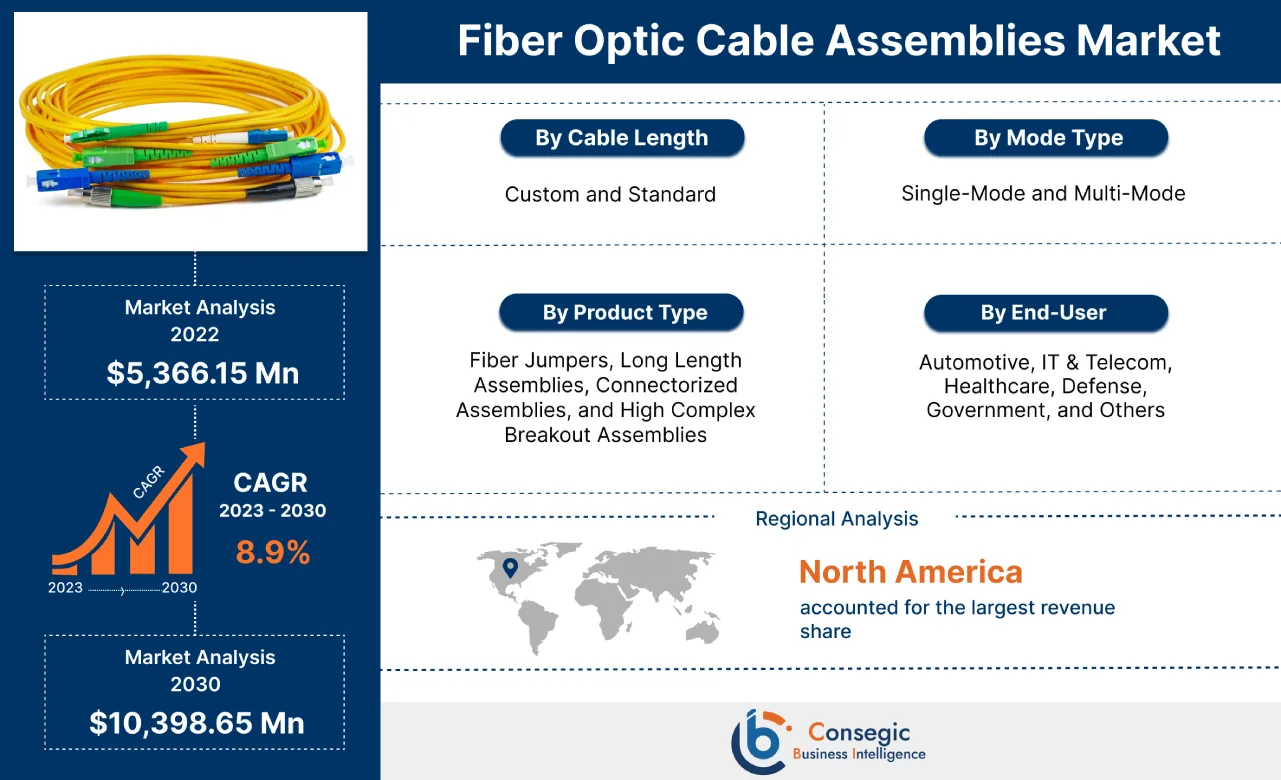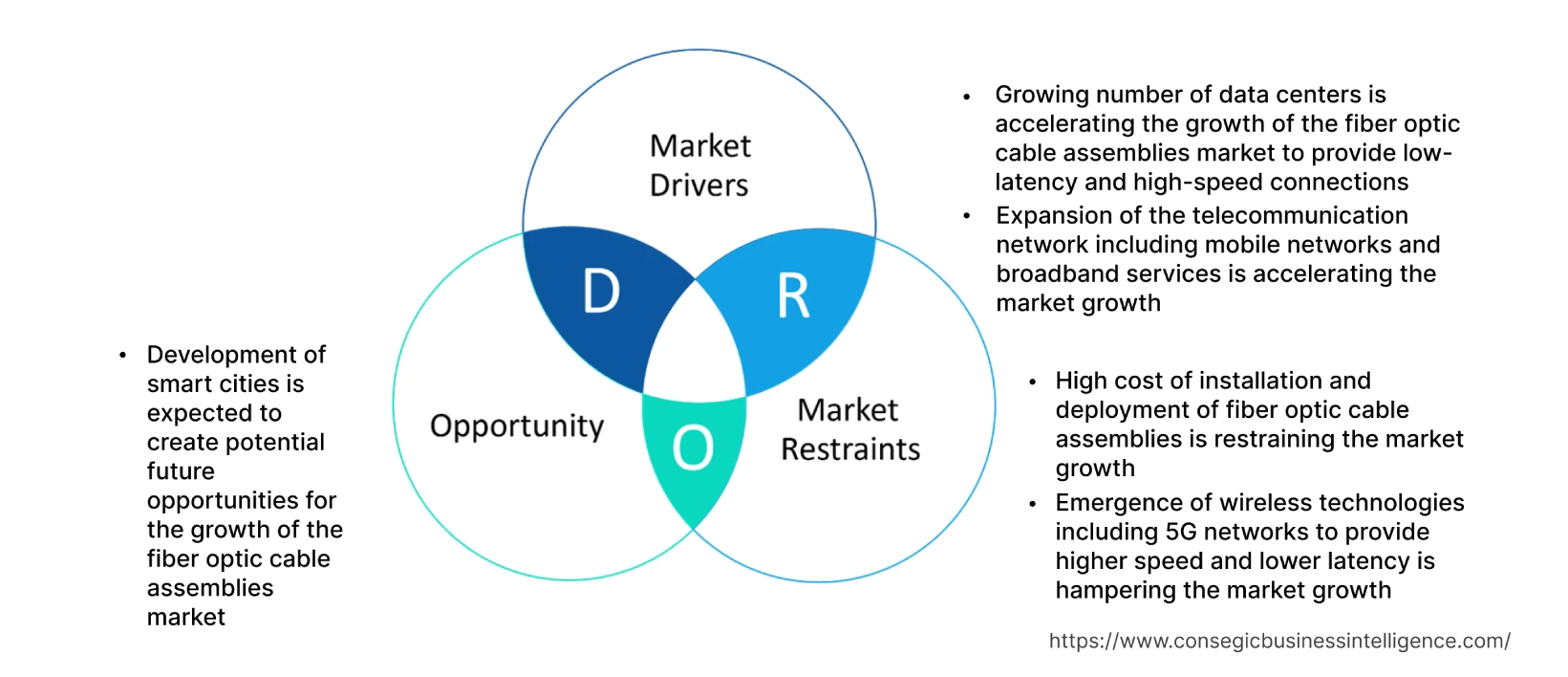Fiber Optic Cable Assemblies Market Introduction :
Global Fiber Optic Cable Assemblies Market size is estimated to reach over USD 10,398.65 Million by 2030 from a value of USD 5,366.15 Million in 2022, growing at a CAGR of 8.9% from 2023 to 2030.
Fiber Optic Cable Assemblies Market Definition & Overview:
Fiber optic cable assemblies are standardized configurations of optical fibers and associated components designed to transmit data using light signals. They are crucial for enabling high-speed, long-distance data communication in various industries, including telecommunications, networking, data centers, and broadcast. In addition, they provide low signal loss and high bandwidth capacity and thus are ideal for transmitting large volumes of data quickly and reliably over long distances.
Fiber Optic Cable Assemblies Market Insights :
Fiber Optic Cable Assemblies Market Dynamics - (DRO) :
Key Drivers :
Growing number of data centers is accelerating the proliferation of the market to provide low-latency and high-speed connections
Data centers handle large amounts of data, including cloud services, online applications, and storage systems, and require high-speed and reliable connectivity to meet such requirements. Fiber optic cable assemblies offer the necessary bandwidth and data transmission rates to support the increasing data loads efficiently. They provide extremely fast transmission speeds, enabling instantaneous data transfers and reducing latency compared to traditional copper cables. The high transmission speed is essential for time-sensitive applications, real-time data processing, and activities that require immediate response. Analysis of market trends concludes that the increasing number of data centers is driving the fiber optic cable assemblies market demand. For instance, in May 2021, according to the United States International Trade Commission report, approximately 8,000 data centers are present globally, out of which 77% are located in OCED member states and 64% in NATO countries. Additionally, 2,600 data centers are present in the United States and North California encompasses maximum data-intensive firms including Uber, Google, Twitter, and Facebook that raises the need of the cable assemblies to provide high-speed connectivity.
Expansion of the telecommunication network including mobile networks and broadband services
The surge in data-intensive applications namely video streaming, online gaming, and cloud services, raises the demand for upgrading the existing network infrastructures. Fiber optic cable assemblies offer significantly higher bandwidth capabilities compared to traditional copper cables. In addition, they support the increasing data volumes and bandwidth requirements of telecommunications networks, ensuring faster and more reliable data transmission.
Moreover, the growing proliferation of smartphones and tablets is increasing the need for high-speed internet access. Fiber optic cable assemblies enable the delivery of gigabit and higher-speed connections, meeting the requirements of consumers and businesses for fast and seamless internet connectivity. Consequently, the increasing adoption of mobile networks and broadband services is raising their demand to offer higher bandwidth and internet access. For instance, in February 2023, according to the Telecom Regulatory Authority of India, the total number of broadband subscribers accounted to 832.2 million in December 2022 and 12.49 million subscribers submitted the request for Mobile Number Portability (MNP). Additionally, the MNP request increased from 771.94 million on November-22 to 784.43 million on December-22, hence contributing significantly in boosting the market expansion.
Key Restraints :
High cost of installation and deployment of cables
The installation of fiber optic cable assemblies requires significant upfront investment in infrastructure, including the cost of laying cables, setting up equipment, and connecting to existing networks. The high initial costs deter some organizations, particularly smaller enterprises with limited budgets, from adopting fiber optics and expanding the existing networks. Analysis of market trends concludes that the cost of fiber optic equipment and components namely connectors, terminations, and splicing tools is also high, contributing to additional upfront costs, thus restraining the proliferation of the global market.
Emergence of wireless technologies including 5G networks
5G networks provide extremely fast wireless connectivity, with the potential to offer multi-gigabit speeds, eliminating the need for physical fiber optic cable installations. Additionally, 5G networks offer significantly lower latency in comparison to fiber optic cable assemblies, critical for real-time applications, including autonomous vehicles, remote surgery, and virtual reality. Moreover, 5G networks excel in providing seamless connectivity and are designed to support high-speed connections for mobile devices, enabling users to remotely access high-bandwidth applications. Analysis of market trends concludes that the emergence of 5G networks to provide higher data connectivity, lower latency, and improved flexibility in comparison to the cable assemblies is impeding the market proliferation.
Future Opportunities :
Development of smart cities is expected to create potential future opportunities
Smart cities rely on robust and high-speed connectivity to support various applications and services. Fiber optic cable assemblies offer the necessary bandwidth and low latency required for smart city infrastructure. The cable assemblies enable seamless communication between sensors, devices, and systems, ensuring real-time data exchange and efficient operation of smart city components. Additionally, fiber optics play a vital role in smart grid and energy management systems by enabling efficient monitoring and control of electricity distribution, integrating renewable energy sources, and managing power consumption. The cable assemblies offer secure and reliable communication for smart meters, substations, and energy management systems, optimizing energy distribution and promoting sustainability. Analysis of market trends concludes that the development of smart cities is emerging as one of many fiber optic cable assemblies market opportunities that will drive market expansion.
Fiber Optic Cable Assemblies Market Report Insights :
| Report Attributes | Report Details |
| Study Timeline | 2017-2030 |
| Market Size in 2030 | USD 10,398.65 Million |
| CAGR (2023-2030) | 8.9% |
| By Cable Length | Custom and Standard |
| By Mode Type | Single-Mode and Multi-Mode |
| By Product Type | Fiber Jumpers, Long Length Assemblies, Connectorized Assemblies, and High Complex Breakout Assemblies |
| By End-User | Automotive, IT & Telecom, Healthcare, Defense, Government, and Others |
| By Region | North America, Europe, Asia-Pacific, Latin America, and Middle East & Africa |
| Key Players | Fiber Connection Inc., Optec Technology Ltd., Optical Cable Corporation, Finisar Corp., RF Industries, Infinite Electronics International, Inc., Samtec, Inc., TE Connectivity |
Fiber Optic Cable Assemblies Market Segmental Analysis :
Based on the Cable Length :
The cable length segment is bifurcated into standard and custom. In 2022, the Standard segment accounted for the highest fiber optic cable assemblies market share as standard length cable assemblies are designed to meet the needs of a wide range of applications across various industries. Assessment of market trends indicates that standard length assemblies are extensively adopted in telecommunications, data centers, enterprise networks, broadcast, and healthcare, among others. Additionally, the cable assemblies are seamlessly integrated into existing fiber optic networks and systems, enabling smooth connectivity and compatibility across different installations. For instance, Amphenol Fiber Systems International has a set standard cable length of less than 5 feet with a tolerance of 1.5 inches.
Custom length segment are expected to register the fastest CAGR in the market during the forecast period. Analysis of fiber optic cable assemblies market analysis concludes that the growth is attributed to the ability of custom cable assemblies to provide personalized solutions for unique applications, accommodating specific cable lengths, connector types, and other customization needs. In addition, technological advancements are also driving their adoption of as the cables incorporate the latest innovations in fiber optic technology including advanced fiber types, high-density connectors, or specialized shielding. The advancements enable custom cable assemblies to address specific technical requirements and support cutting-edge applications, hence contributing significantly in driving the adoption of customized length cable assemblies.
Based on the Mode Type :
The mode type segment is bifurcated into single-mode and multi-mode. In 2022, the Single-mode segment accounted for the highest fiber optic cable assemblies market share as compared to multi-mode assemblies. The growth of the market is credited to wide adoption of single-mode cable assemblies in long-haul telecommunications, high-speed data networks, and applications requiring long-distance transmission. Examination of market trends concludes that the increasing requirement of high-speed internet, intercontinental connectivity, and long-haul communication is driving the proliferation of the single-mode segment. For instance, in September 2022, Jonard Tools launched FLC-1001 and FLC-1005, single-mode assemblies to eliminate the dead zones in reflectometric tests. The advanced cable fibers are designed to offer high-speed internet connectivity and bandwidth, enabling seamless communication, thus contributing notably in bolstering the fiber optic cable assemblies market growth.
Multi-mode assemblies are predicted to witness the fastest CAGR in the market during the forecast period. The growth of the market is endorsed by the increasing application of multi-mode fiber cable assemblies to enable shorter distance communication, within buildings, campuses, data centers, and local area networks (LANs). In addition, multi-mode fibers have larger core form factor, allowing for multiple modes of light transmission, and are more susceptible to modal dispersion. In conclusion, the aforementioned factors including the increasing adoption of multi-mode fiber cable assemblies in various sectors owing to the larger core size are contributing significantly in spurring the fiber optic cable assemblies market growth.
Based on the Product Type :
The product type segment is classified into fiber jumpers, long length assemblies, connectorized assemblies, and high complex breakout assemblies. Fiber jumpers, also known as patch cords or patch cables, accounted for the largest market share in 2022 in the fiber optic cable assemblies market. The growth is attributed to the increasing adoption of patch cables in data centers, telecommunications networks, LANs, and other environments to offer quick and reliable connectivity. Examination of market trends concludes that patch cables are more cost-effective in comparison to other cable assemblies products, further contributing to market expansion. For instance, in February 2023, Leviton Manufacturing Co., Inc. introduced high-quality patch cords to enhance Cat 6A and Cat 6 solutions by providing improved durability, flexibility, and reduced bend radius. The product is designed to offer high-speed connectivity in smart building devices and IoT applications, hence contributing remarkably in driving the market proliferation.
Connectorized assemblies are expected to witness the fastest CAGR in the fiber optic cable assemblies market during the forecast period. Connectorized assemblies are factory-terminated under controlled conditions, ensuring consistent and reliable performance. Additionally, the pre-terminated nature of connectorized assemblies significantly reduces labor costs associated with field terminations. The assemblies eliminate the need for skilled technicians to perform on-site terminations, thereby reducing installation time and expenses. Consequently, the aforementioned factors are responsible for accelerating the expansion of connectorized assemblies in the upcoming years.
Based on the End-User :
The end-user segment is classified into automotive, IT & telecom, healthcare, defense, government, and others. IT & telecom accounted for the largest market share of 27.7% in 2022 as the it generates and transmits vast amounts of data globally. The cable assemblies offer the high-speed and high-bandwidth capabilities required to handle data traffic efficiently. In addition, with the rising demand for data-intensive applications namely cloud computing, and streaming services, the need for cable assemblies is also increasing. Moreover, fiber optics provide the speed and capacity required for reliable internet connectivity, thus contributing significantly in fueling the proliferation of the IT and telecom sector. Consequently, the expanding IT industry is raising the demand for cable assemblies to provide seamless data transmission. For instance, in February 2023, according to India Brand Equity Foundation (IBEF), the IT sector accounted to 7.4% of India's GDP in FY22 and is expected to reach 10% by 2025. Analysis of fiber optic cable assemblies market trends concludes that the expansion in the IT sector, thus contributes remarkably in driving the proliferation of the fiber optic cable assemblies market.
Healthcare sector is anticipated to witness the fastest CAGR in the fiber optic cable assemblies market during the forecast period. The cable assemblies are utilized in medical imaging systems including MRI (Magnetic Resonance Imaging), CT (Computed Tomography), and X-ray machines. The cable assemblies transmit high-resolution images and data from the imaging devices to the display or storage systems. Fiber optics offer excellent image quality, low signal loss, and electromagnetic interference immunity, ensuring accurate and reliable medical imaging. Additionally, the cable assemblies are integral to endoscopic procedures, which involve inserting a flexible or rigid endoscope into the body for diagnostic or surgical purposes. Fiber optics transmit light to illuminate the body cavity and transmit images captured by the endoscope's camera to the viewing system, hence contributing remarkably in propelling the market expansion.
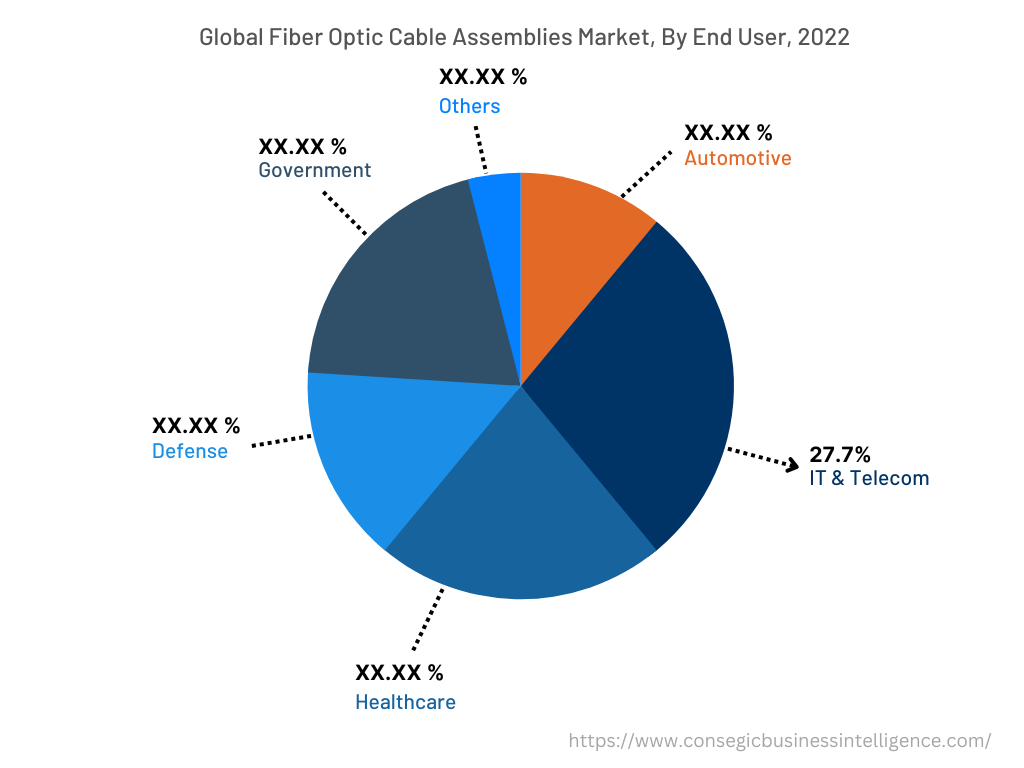
Based on the Region :
The regional segment includes North America, Europe, Asia Pacific, Middle East and Africa, and Latin America.
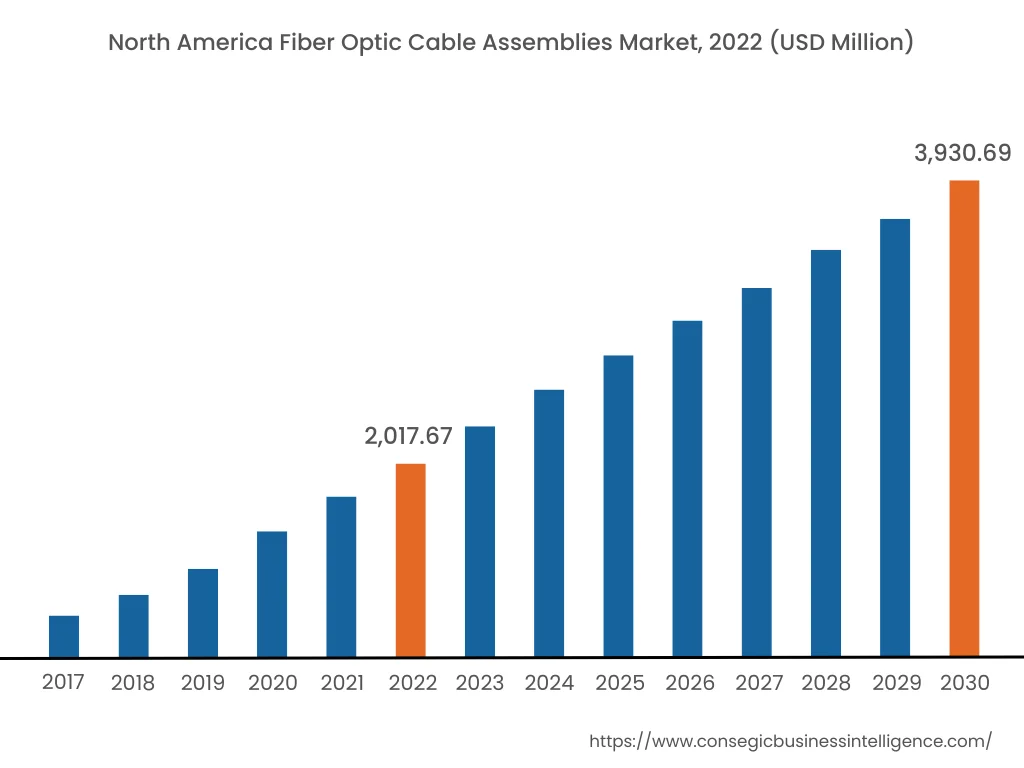
North America accounted for the largest revenue share of USD 2,017.67 million in 2022 and is predicted to reach USD 3,930.69 million in 2030 in the fiber optic cable assemblies market. In addition, in the region, the U.S. accounted for the maximum revenue share of 56.65% in the year 2022. The fiber optic cable assemblies market analysis concluded that growth is attributed to a large number of data centers, including major cloud service providers and technology companies. Data centers rely heavily on the cable assemblies to interconnect servers, storage systems, and networking infrastructure. The region's thriving data center industry is driving the demand for the cable assemblies in North America. In addition, the presence of key players in the region including Corning Inc., NAI Group, LLC, and CommScope are constantly investing in research and development is also contributing significantly in accelerating the market expansion. For instance, in October 2022, NAI Group, LLC established several new facilities to design and test optic cable assemblies, box builds, and harnesses. The new facilities comprise 85 engineers, experts, and technicians to test optic cable assemblies, hence contributing remarkably in propelling the market expansion in the region.
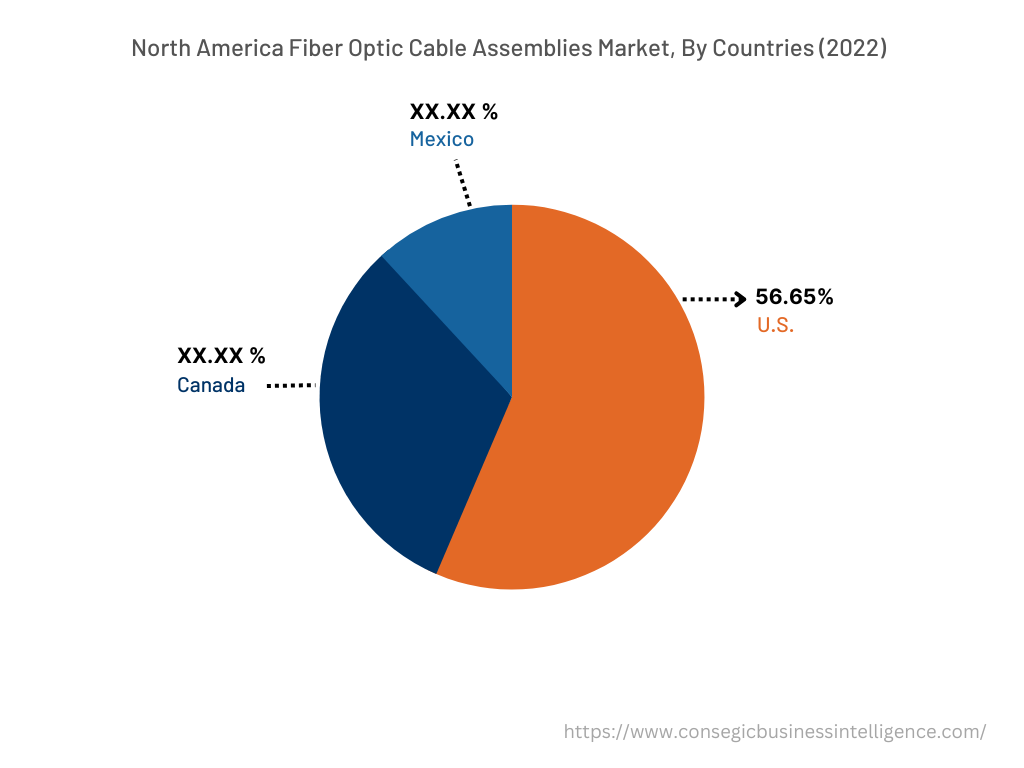
Asia Pacific accounted is expected to register the fastest CAGR of 9.3% owing to the growing consumer base for digital services, e-commerce, and online entertainment. The increased internet usage and demand for bandwidth-intensive applications are fueling the need for robust and high-speed connectivity. The assemblies provide the necessary capacity to support the growing digital services, contributing to higher adoption and market growth in the region.
Additionally, governments in Asia Pacific countries are launching initiatives and investing significantly to expand broadband infrastructure, including fiber optic networks. The fiber optic cable assemblies market analysis concluded that these initiatives, coupled with supportive policies and funding, create a favorable environment for the expansion of the market in the Asia Pacific.
Top Key Players & Market Share Insights :
The landscape of the optic cable assemblies market is highly competitive and has been examined in the report, along with complete profiles of the major companies operating in the fiber optic cable assemblies industry. In addition, the surge in innovations, acquisitions, mergers, and partnerships has further accelerated the expansion of the optic cable assemblies market. Major players in the market include-
- Fiber Connection Inc.
- Optec Technology Ltd.
- Samtec, Inc.
- TE Connectivity
- Optical Cable Corporation
- RF Industries
- Finisar Corp.
- Infinite Electronics International, Inc.
Recent Industry Developments :
- In April 2023, Infinite Electronics International, Inc. brand L-com expanded its line of Multi-Fiber push on (MPO) fiber optic, ODVA-compatible, and outdoor cable assemblies. The new cables are resistant to water and dust, and suitable for various outdoor applications such as broadcast and, transportation.
- In December 2021, Samtec, Inc. announced the acquisition of Ultra Communications, Inc. to strengthen and expand its fiber optic product portfolio using Ultra Communication's advanced product and technology solutions.
Key Questions Answered in the Report
What is a fiber optic cable assembly? +
Fiber optic cable assemblies are standardized configurations of optical fibers and associated components designed to transmit data using light signals.
What specific segmentation details are covered in the fiber optic cable assemblies market report, and how is the dominating segment impacting the market growth? +
IT & telecom accounted for the largest market share in 2022 as the IT and telecom industry generates and transmits vast amounts of data globally. Fiber optic cable assemblies offer the high-speed and high-bandwidth capabilities required to handle data traffic efficiently.
What specific segmentation details are covered in the fiber optic cable assemblies market report, and how is the fastest segment anticipated to impact the market growth? +
Healthcare sector is anticipated to witness the fastest CAGR as fiber optic cable assemblies are utilized in medical imaging systems including MRI (Magnetic Resonance Imaging), CT (Computed Tomography), and X-ray machines. The cable assemblies transmit high-resolution images and data from the imaging devices to the display or storage systems.
Which region is anticipated to witness the highest CAGR during the forecast period, 2023-2030? +
Asia Pacific is anticipated to witness the fastest CAGR during the forecast period owing to the growing consumer base for digital services, e-commerce, and online entertainment.
